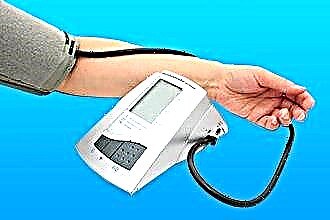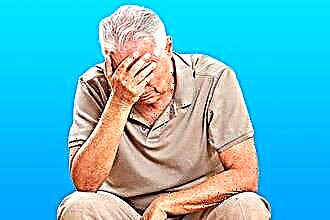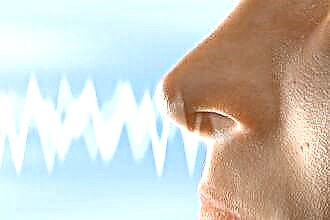Low blood pressure in an elderly person is a rare situation. This condition is associated with a congenital predisposition, body type and other factors. Nevertheless, it can also occur in hypertensive patients, more often with the wrong use of antihypertensive drugs. The consequences of a situation are quite serious - fainting often occurs, intellectual abilities are impaired. Medicines and physical therapy are used for treatment.
Causes of low blood pressure in the elderly
 Most often, with age, the upper limit of blood pressure (BP) rises. This is a normal process, although it is often associated with such a dangerous disease as hypertension. There are also opposite cases: the elderly develop low blood pressure (hypotension).
Most often, with age, the upper limit of blood pressure (BP) rises. This is a normal process, although it is often associated with such a dangerous disease as hypertension. There are also opposite cases: the elderly develop low blood pressure (hypotension).
Normal rates for a person at 30 and at 60 are different. Systolic (upper) pressure of 140 mm Hg. Art. for a young man it will be elevated, and for an elderly patient it will be normal.
Usually hypotension occurs under the influence of several factors that disrupt the regulation of the internal environment of the body:
- Sports - People who actively train in their youth have a lower comfort pressure.
- Weather changes - in old age, meteosensitivity increases.
- Taking antihypertensive drugs (including the wrong one: exceeding dosages), or the combined use of drugs that enhance the effect of each other, can lead to a decrease in blood pressure.
- Psychoemotional stress causes dysfunction of the nervous system, resulting in impaired regulation of blood pressure .;
- Postprandial hypotension occurs after eating. The parasympathetic nervous system is activated, which narrows some of the peripheral arteries and veins, dilating them in the gastrointestinal tract. It promotes digestion, but disrupts the flow of blood to the brain and heart.
- Orthostatic hypotension is characterized by a decrease in blood pressure as a result of a sharp change in body position from horizontal to vertical. Its causes can be prolonged bed rest, varicose veins, other cardiopathologies and endocrine disorders.
Involutional (age-related) changes in blood vessels have a significant impact, making them less elastic, thereby exposing them to negative influences.
Sometimes hypotension is associated with a genetic or constitutional predisposition. Thin people who had low blood pressure in their youth have even lower rates in old age.
Hypotension is often found among patients with the following groups of pathologies:
 Cardiovascular diseases (ischemic disease, chronic insufficiency). Hypotension occurs as a result of a decrease in contractile function. Systolic volume falls, lowering blood pressure.
Cardiovascular diseases (ischemic disease, chronic insufficiency). Hypotension occurs as a result of a decrease in contractile function. Systolic volume falls, lowering blood pressure.- The presence of internal bleeding (most often from the gastrointestinal tract) leads to a decrease in the volume of circulating blood (BCC), and, as a result, pressure. With a chronic course, anemia occurs.
- Infectious diseases. Under the influence of bacterial toxins, the lumen of the vessels can expand. In addition, they negatively affect the contractility of the myocardium. Some infections are accompanied by vomiting and diarrhea, which also lowers the BCC.
- Dehydration occurs both due to insufficient intake of fluid into the body, and with its increased excretion. This often happens with fever, kidney disease, which are accompanied by polyuria (increased urination), massive vomiting and diarrhea.
- Addison's disease is an insufficiency of the adrenal glands. It leads to a deficiency of mineralocorticoids - hormones that are responsible for the regulation of blood pressure.
- With vegetative-vascular (neurocirculatory) dystonia, there is a breakdown in the connection between the cerebral cortex and the hypothalamus, as a result of which the regulation of some physiological processes in the body, including pressure, is disrupted. Most often, this condition develops in young people, especially in women.
Aging of blood vessels: what is it from a medical point of view
Blood vessels are subject to aging. Age is reflected in their functional state, which ultimately also affects blood pressure.
Allocate structural and functional changes.
 Violation of the elasticity of the vascular wall in the first group. It occurs due to the proliferation of connective tissue and atherosclerotic plaques. Smooth muscles atrophy, as a result of which the vessel stretches and cannot contract. The large main arteries are more susceptible to the process. The affected capillaries become convoluted and elongated, many of them are completely obliterated (overgrown), as a result of which peripheral resistance increases and venous stasis occurs.
Violation of the elasticity of the vascular wall in the first group. It occurs due to the proliferation of connective tissue and atherosclerotic plaques. Smooth muscles atrophy, as a result of which the vessel stretches and cannot contract. The large main arteries are more susceptible to the process. The affected capillaries become convoluted and elongated, many of them are completely obliterated (overgrown), as a result of which peripheral resistance increases and venous stasis occurs.
In older people, veins expand, the tone of their walls decreases, varicose veins, phlebitis and other diseases can occur. Against this background, venous return to the heart and its systolic output decreases, which is one of the main causes of low blood pressure.
The endothelium (inner epithelial layer) has not only a protective function, but also a regulatory one. It produces biologically active substances that affect the tone of the vessel and its permeability. Aging of this system leads to a change in the total peripheral resistance.
All of the above mechanisms are more likely to lead to an increase in blood pressure with age. But there are exceptions, and blood pressure falls in similar situations.
Clinical picture
Pathology is characterized by symptoms of impaired cerebral hemodynamics and hypoxia of other organs:
 weakness, fatigue, apathy, drowsiness;
weakness, fatigue, apathy, drowsiness;- meteosensitivity;
- distraction of attention, memory impairment;
- emotional lability, irritability;
- shortness of breath on exertion;
- tachycardia;
- dizziness, syncope (fainting);
- headache (usually in the frontal and temporal lobes);
- pallor of the skin, hyperhidrosis (sweating).
Treatment
The condition provides for conservative therapy. The patient needs to constantly monitor his blood pressure with a tonometer and inform the doctor about any changes. Before using any medicines, you should consult a specialist.
First aid: what is best to have on hand
With a sudden drop in blood pressure, your help should be to ensure normal cerebral blood flow. Algorithm of actions:
- Place the person on the bed. The head cannot be held in an elevated position. Lower it to improve blood flow to the brain.
- Open the window, unbutton tight clothes.
- Give the sick person a warm, sweet tea or coffee to drink. Offer him dark chocolate or something salty - these foods tend to increase blood pressure.
- If there is no caffeine at home, give the person citramone, panadol, or ascofen - these contain lower concentrations of this substance.
- If someone has lost consciousness, give him a sniff of ammonia. Apply a few drops to a napkin / handkerchief and bring it to your nostrils.
When such measures are not effective, call an ambulance. If the person is unconscious, turn him on his side.
Ongoing drug support
After determining the cause of hypotension, drugs are prescribed to treat the underlying disease.
 Drug therapy for maintaining a stable pressure includes drugs of the following groups:
Drug therapy for maintaining a stable pressure includes drugs of the following groups:
- Caffeine-containing agents that stimulate the activity of the nervous system, increase muscle tone (including those in the vascular wall), and activate metabolic processes. The standard dosage for an adult is 1 tablet (200 mg) per day. It is strictly contraindicated in the presence of arrhythmias. In pharmacies, it is found under the name Caffeine Sodium Benzoate.
- Herbal adaptogens are drugs with a general tonic effect. These include:
- Eleutherococcus tincture;
- Chinese schisandra;
- Echinacea purpurea;
- Ginseng.
- Nootropic drugs (cerebroprotectors) - have protective properties, increase resistance to hypoxia, improve cognitive abilities (memory, intelligence), and normalize sleep. Among them are:
- Piracetam;
- Glycine;
- Noofen;
From folk remedies for increasing pressure, you can use the following medicinal plants:
- milk thistle leaves;
- sea buckthorn;
- motherwort grass;
- liquorice root.
It is necessary to observe preventive measures: it is recommended to take walks in the fresh air more often, exercise, take a contrast shower. To avoid orthostatic collapse, it is necessary to get out of bed slowly, moving first to a sitting position, then standing.
Dangerous complications
Many people are dismissive of arterial hypotension, because very often its only symptoms are drowsiness and dizziness. It rarely leads to dangerous complications, such as a heart attack or stroke, in contrast to hypertension. Meanwhile, spontaneous syncope and its consequences are extremely severe.
 Low blood pressure leads to a decrease in the perfusion (blood supply) of many organs and systems. The most sensitive cells are myocardial and brain cells. Due to reduced blood flow, they receive less oxygen and nutrients, which is fraught with hypoxia.
Low blood pressure leads to a decrease in the perfusion (blood supply) of many organs and systems. The most sensitive cells are myocardial and brain cells. Due to reduced blood flow, they receive less oxygen and nutrients, which is fraught with hypoxia.
With a decrease in cerebral blood flow, a person will first of all feel sleep disturbances. Then he will have problems with memory, concentration. Thinking will become more sluggish and incoherent. As a result, the above processes can lead to dementia - senile dementia.
The presence of orthostatic hypotension often causes syncope. As a rule, after them a person quickly recovers, but sometimes a fall can cause severe head injuries.
If the heart muscle does not receive enough oxygen, its contractile ability decreases, which leads to an even greater decrease in blood pressure. A vicious circle arises: a decrease in the force of contraction and oxygen starvation.
Conclusions
Low blood pressure is rare in people over 50. The main reason for the phenomenon is considered a genetic predisposition. This condition (sometimes caused by ischemic heart disease, or impaired renal function) can be accompanied by a sharp disruption of cerebral blood supply, and therefore requires close attention.
Treatment of hypotension in the elderly includes the use of medications such as caffeine and tonic herbal preparations. Physiotherapy measures are also recommended to the patient.

 Cardiovascular diseases (ischemic disease, chronic insufficiency). Hypotension occurs as a result of a decrease in contractile function. Systolic volume falls, lowering blood pressure.
Cardiovascular diseases (ischemic disease, chronic insufficiency). Hypotension occurs as a result of a decrease in contractile function. Systolic volume falls, lowering blood pressure. weakness, fatigue, apathy, drowsiness;
weakness, fatigue, apathy, drowsiness;

